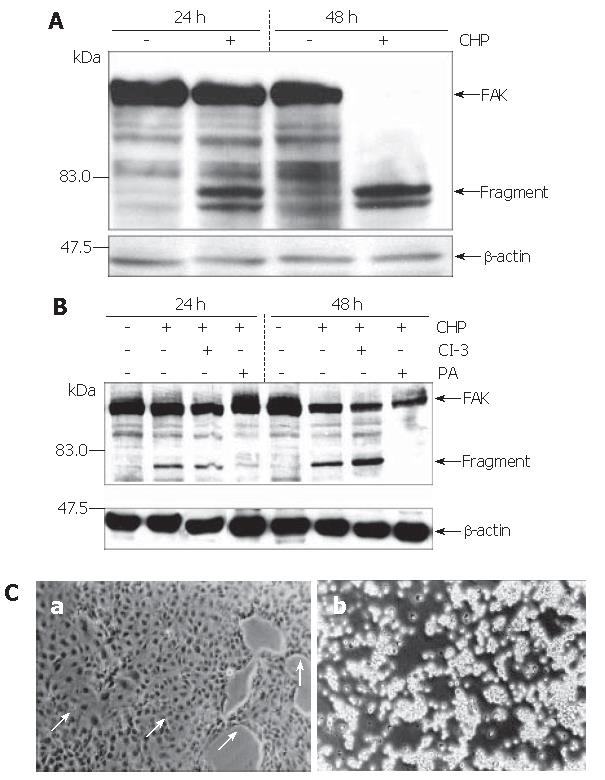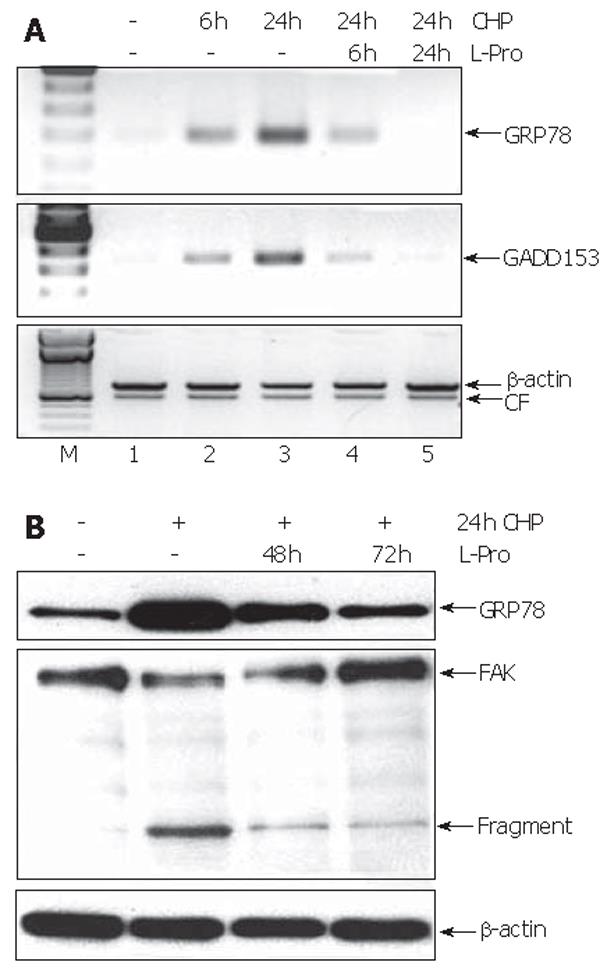Copyright
©2006 Baishideng Publishing Group Co.
World J Gastroenterol. Mar 14, 2006; 12(10): 1569-1576
Published online Mar 14, 2006. doi: 10.3748/wjg.v12.i10.1569
Published online Mar 14, 2006. doi: 10.3748/wjg.v12.i10.1569
Figure 1 Effect of CHP on morphological appearance of DSL6A cell (Phase contrast microscopy, original magnification x200).
A: Adherently growing controls; B: Incubation with 10 mmol/L CHP for 24 h caused rounding, followed by detachment of DSL cells; C: Addition of 20 mmol/L L-proline abolished the effects of CHP; D: CHP-treated cells cultured for further 48 h with 20 mmol/L L-proline, resulting in the re-adherence of the cells.
Figure 2 Inhibition of cell proliferation and survival by CHP.
A: After the addition of BrdU, cells were cultured for further 20 h, followed by quantification of BrdU incorporation; B: Four hours after the addition of CellTiter AQueous solution, conversation of the MTT salt was measured. CHP-caused decrease of proliferation (A) and metabolically active cells (B) was prevented by the addition of L-proline. Results are expressed as mean±SE (n = 6, aP≤ 0.05). C: Immunoblotting of total cell extracts from DSL6A cells using an anti-cyclin D1 antibody. Results are representative for three independent experiments. D: DSL6A cells were treated with 10 mmol/l CHP for 24 h before culture medium was (a) replaced by DMEM without CHP or (b) 20 mmol/L L-proline was added to the CHP-containing medium.
Figure 3 FAK fragmentations in DSL6A cells induced by CHP.
A Immunoblotting of protein extracted from DSL6A cells after being incubated for 16 h and 48 h with or without 10 mmol/L CHP. CHP induced a time-dependent degradation of the 125 ku FAK protein, resulting in fragments of about 80 ku. B Simultaneous addition of the Protease Arrest Reagent (PI) to the CHP-treated cells attenuated fragmentation of FAK; in contrast, the caspase-3 inhibitor z-DEVD-fmk (CI-3, 100 μmol/L) was not able to abolish the CHP-induced FAK degradation. To show equal protein loading, the membranes were stripped and re-probed using an anti-β-actin specific antibody. C Effect of CHP on morphological appearance of DSL6A cells; (a) simultaneous addition of 10 mmol/L CHP and a broad spectrum protease inhibitor (PI, Protease Arrest Reagent) abolished the CHP-induced loss of adherence; (b) In contrast to the broad spectrum protease inhibitor, the caspase-3 inhibitor z-DEVD-fmk (CI-3, 100 μmol/L) had no effect on the CHP-induced loss of adherence (Phase contrast microscopy, original magnification x 200).
Figure 4 Immunocytochemical localisation of FAK.
DSL6A cells grown on glass cover slips were cultured for 24 h without (A) or with 10 mmol/L CHP (B). Cell staining was performed by incubation with a mouse anti-FAK specific antibody. Binding of the primary antibody was detected by an AlexaFluorTM-labelled anti-mouse antibody. Arrows: focal adhesions; Bar: 10 μm.
Figure 5 Influence of CHP on expression of GRP78 and GADD153.
A: RT-PCR; M = 100-bp molecular weight marker; B: Western blot.
Figure 6 Reversion of CHP-mediated molecular effects by L-proline.
A: RT-PCR analysis of mRNA expressions of GRP78 and GADD153. Lane 1: DSL6A cells cultured without 10 mmol/L CHP for 6 h; lane 2: DSL6A cells cultured with 10 mmol/L CHP for 6 h; lane 3: DSL6A cells cultured with 10 mmol/L CHP for 24 h; lane 4: DSL6A cells treated for 24 h with CHP after the addition of 20 mol/L L-proline for further 6 h; lane 5: DSL6A cells treated for 24 h with CHP after the addition of 20 mol/L L-proline for further 24 h. B: Western blot analysis of GRP78 and FAK protein. Results are representative of at least three independent experiments.
Figure 7 Induction of apoptosis by CHP.
A: Immunoblotting using specific antibodies for cleaved caspase-3 or poly (ADP) ribose polymerase (PARP). B: DNA laddering induced by CHP. Results are representative of at least three independent experiments.
Figure 8 Survival of DSL6A cells cultured in suspension.
A: Assessment of cell viability using the CellTiter AQueous assay. Adherent cells (adh.) and cells in suspension (susp.) were incubated for 24 h with or without 10 mmol/L CHP. Results are expressed as a percentage of living cells with regard to adherently growing, untreated control. Data are expressed as mean±SE (n = 6). B: Western blot analysis of FAK protein levels.
- Citation: Mueller C, Emmrich J, Jaster R, Braun D, Liebe S, Sparmann G. Cis-hydroxyproline-induced inhibition of pancreatic cancer cell growth is mediated by endoplasmic reticulum stress. World J Gastroenterol 2006; 12(10): 1569-1576
- URL: https://www.wjgnet.com/1007-9327/full/v12/i10/1569.htm
- DOI: https://dx.doi.org/10.3748/wjg.v12.i10.1569




















